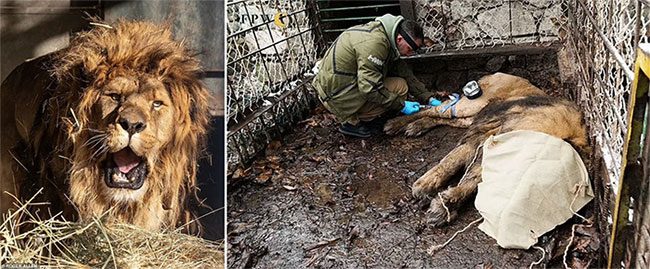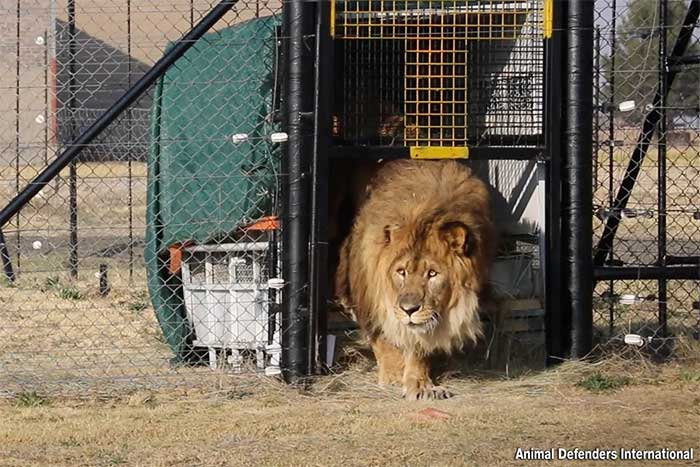Dubbed the “world’s loneliest lion,” Ruben has completed a journey of over 8,300 km to return to his homeland in South Africa and take his first steps into the natural world.
The 15-year-old male lion named Ruben gained international attention when the border conflict between Armenia and Azerbaijan erupted in mid-2018, causing the zoo where Ruben lived to close down. This was a private zoo located in Armenian territory, near the Azerbaijan border.
While other animals at the zoo were relocated, Ruben had to remain because there was no cage available for transport. He was confined in a cramped cage under extremely poor conditions at the zoo, with only one staff member assigned to care for him.

Ruben lived in poor conditions, in a cramped cage for 5 years before being rescued. (Photo: ADI).
When images of Ruben’s deplorable confinement were shared on social media, many netizens nicknamed him the “world’s loneliest lion.”
In response to Ruben’s tragic situation, the Animal Defenders International (ADI) – a non-profit animal protection organization – launched a campaign to rescue the male lion.
ADI experts reported that when they arrived at the zoo where Ruben was kept, the animal was in poor health due to malnutrition and lack of exercise. He lived in such isolation that he had forgotten how to roar, an action that signifies the strength of the “lords of the savannah.”
By June, ADI achieved a significant milestone in the rescue process, successfully removing Ruben from his cramped cage and transferring him to a bear sanctuary in Armenia for care. ADI’s next goal was to return Ruben to his homeland in South Africa.
“We hope to soon receive approval for the paperwork and exit documents to bring Ruben back to South Africa,” said Tim Phillips, co-founder and Vice President of ADI, in an interview earlier this March.
Recently, ADI’s efforts were rewarded when Ruben completed the long journey of over 8,300 km, from Armenia to South Africa. He was sedated and transported in a metal cage by air to South Africa.

Ruben takes his first steps in his homeland, South Africa after many years. (Photo: ADI).
Qatar Airways Cargo supported ADI in transporting Ruben by providing a cargo plane with a loading door large enough to accommodate his cage.
After the long journey, Ruben was transferred to the Free State Nature Reserve in South Africa. The animal quickly recovered after the long trip and easily adapted to his new environment.
“Lions are social big cats that live in groups in the wild. Therefore, Ruben’s inability to communicate or interact with other lions was certainly a terrible thing,” said Jan Creamer, President of ADI.
“Seeing Ruben walk on the grass for the first time, with the African sun on his back, made us all tear up,” Jan Creamer added. “The animal’s demeanor has improved significantly; he has become more comfortable and no longer fearful.”
Ruben can now regain his roar and is learning to interact with other lions at the Free State Reserve. He will continue to be monitored by ADI experts regarding his health to ensure he adapts well to his new environment and to prevent any potential rejection by other lions in the reserve.
Typically, the lifespan of male lions in the wild ranges from 15 to 16 years, while female lions live between 8 to 10 years. In captivity, lions can live significantly longer, up to 20 years, due to better care and the absence of the need to hunt.
A male lion named Arjun is recorded as the longest-living lion in the world, reaching an age of 29. Arjun was born and raised at the Wildlife Rescue Center in India and had never lived a day in the wild.
Arjun passed away on May 17, 2018, due to multiple organ failure related to old age.
Another male lion named Loonkito is recognized as the oldest lion living in the wild. This animal lived in Amboseli National Park (Kenya) but was killed by herders with a spear when he entered the village to attack livestock and search for food. At the time of his death, Loonkito was 20 years old.





















































